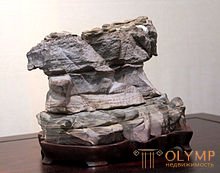
Suiseki (as well as Monseki and Gongshi). Art is a native of the Far East (Japan, China, Korea), something akin to the Russian root plastics, but instead of "snags" - raw stones.
Most often, these stones are called the Japanese term Suiseki, but this is not quite accurate- Suiseki- stones turned by water (Suy-water, Seki-stone), but there are still Gongshis (stones in the style of Chinese schools) Mon-seki (stones with an interesting pattern) , Sabaku-Ishi (desert stones, which acquired an interesting shape as a result of cracking). There are many more types and classes, but each of them belongs to one of the above groups.
The general rule is that stones are not processed at all, only patinated with special oils are applied, which allows for a brighter structure and pattern. Stands, of course, are made separately, but according to the "rules of craftsmanship" stones are forbidden to glue. You also can not stick stones together, polish, etc. (these are the "rules of the game" based on the Buddhist idea of the animate nature of everything.
Suiseki - a traditional genre of Japanese art with more than a thousand-year history of development. Arishige Matsuura, President of Nippon suiseki kyokai, defines suiseki as follows: "This is comprehension of nature and enjoying it in stone, which is nature in itself"; suyseki is a “stone not treated by man”. It is the Eastern worldview that allows you to see in the stone a source of meditation and inspiration.
“Philosophical” - this name perfectly defines the unique art of suisek stones. Suiseki embody many facets: naturalness and minimalism, Zen philosophy, contemplation and the achievement of harmony with nature. Souisek will be an original gift and a wonderful interior decoration.

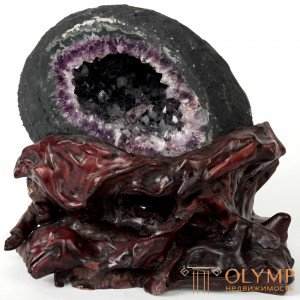
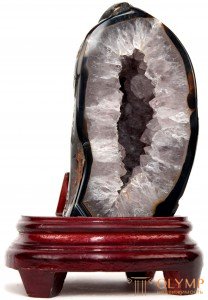
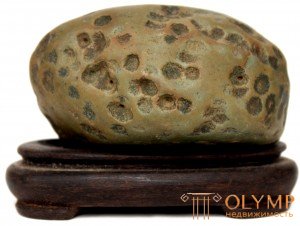

The aesthetic value of the stone is determined by the shape, quality, color, surface and age. Perfection is based on the balance of elements, of which form is the most important. The stone should make a harmonious impression from any of the points of view. Any stone that at first glance resembles something unnatural is completely unsuitable. The stone must have adequate hardness. Soft stones overgrow with moss too quickly, lava too fragile. When wetted, it should remain wet for as long as possible.
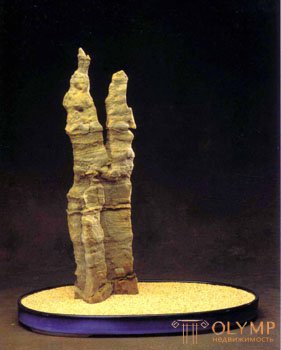 Usually for suyseki used stones from mountain rivers, the source flow; but the necessary qualities are rarely found in the "new" stones recently removed from the water. The stone must be put on a bright place and watered in order to speed up the aging process, and after several years of care, the stone will turn into suyseki. There are other ways to create the required surface quality. The older a stone is, the more attention and labor is attached to it, the more valuable it is. Suiseki is the result of a long process. In Japan, the development and improvement of the beauty of a new stone requires a minimum of 10 years of care, and sometimes much more. Revision or cutting stones, as a rule, is not allowed in accordance with the religious beliefs of Zen Buddhism: it could destroy the "soul of the stone." Processing in some way is permissible only for so-called "landscape stones"
Usually for suyseki used stones from mountain rivers, the source flow; but the necessary qualities are rarely found in the "new" stones recently removed from the water. The stone must be put on a bright place and watered in order to speed up the aging process, and after several years of care, the stone will turn into suyseki. There are other ways to create the required surface quality. The older a stone is, the more attention and labor is attached to it, the more valuable it is. Suiseki is the result of a long process. In Japan, the development and improvement of the beauty of a new stone requires a minimum of 10 years of care, and sometimes much more. Revision or cutting stones, as a rule, is not allowed in accordance with the religious beliefs of Zen Buddhism: it could destroy the "soul of the stone." Processing in some way is permissible only for so-called "landscape stones"
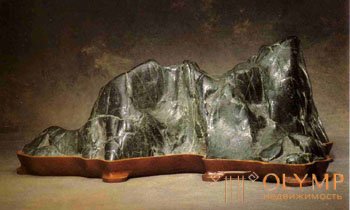 A very important aspect of the impact of suyseki on the imagination and the subconscious of the viewer is his inherent color. The color of suyseki should be natural, that is, correspond to soft tones inherent to nature. Very important qualities such as elegance and serenity, inherent, for example, water-treated black stone. The same feeling of a dark brown, blue-black, dark gray stone. White color is undesirable, as in Japan is mourning. (However, in the Chinese tradition, on the contrary, the use of white and light colors).
A very important aspect of the impact of suyseki on the imagination and the subconscious of the viewer is his inherent color. The color of suyseki should be natural, that is, correspond to soft tones inherent to nature. Very important qualities such as elegance and serenity, inherent, for example, water-treated black stone. The same feeling of a dark brown, blue-black, dark gray stone. White color is undesirable, as in Japan is mourning. (However, in the Chinese tradition, on the contrary, the use of white and light colors).
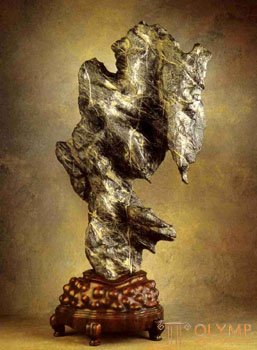 Among the factors that contributed to the development of aesthetics of suyseki, should be called the art of tea. It was the tea ceremony that contributed to the increase in the aesthetic role of stones. Many masters of tea drinking used them as a means of artistic expression in organizing a tea event. For the most part, small, dark stones, called Chaseki, are preferred. Another important source of development of suyseki is in cooperation and interpenetration with bonsai. Both of these arts help your imagination to travel to a different time and place. The stones, correctly located, resemble the forms of the earth's surface: a mountain range, an island or a dramatic waterfall. Common to both forms is imagination, which allows one to step over into a miniature landscape of bonsai or suyseki. Many stones, originally used as elements of bonsai, eventually become suyseki. A common feature of the two genres is also a way to solve the problem of organizing relations between an object and its surrounding space. Finally, suyseks, like bonsai, use flat ceramic-suibana vessels to place stones. Another common option is to use a carved wooden stand that follows the shape of a stone.
Among the factors that contributed to the development of aesthetics of suyseki, should be called the art of tea. It was the tea ceremony that contributed to the increase in the aesthetic role of stones. Many masters of tea drinking used them as a means of artistic expression in organizing a tea event. For the most part, small, dark stones, called Chaseki, are preferred. Another important source of development of suyseki is in cooperation and interpenetration with bonsai. Both of these arts help your imagination to travel to a different time and place. The stones, correctly located, resemble the forms of the earth's surface: a mountain range, an island or a dramatic waterfall. Common to both forms is imagination, which allows one to step over into a miniature landscape of bonsai or suyseki. Many stones, originally used as elements of bonsai, eventually become suyseki. A common feature of the two genres is also a way to solve the problem of organizing relations between an object and its surrounding space. Finally, suyseks, like bonsai, use flat ceramic-suibana vessels to place stones. Another common option is to use a carved wooden stand that follows the shape of a stone.
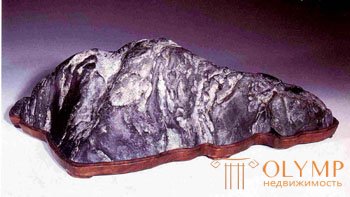 Centuries of development in the art of suyseki formed a classification system that allows you to determine the place and evaluation criteria for almost any stone. In this complex and diverse system, the most common group is landscape. All landscape stones can be broken into styles: mountain landscapes, waterfalls or caves, arches, bridges and plateaus, peaks, cliffs and rocks, and so on. The next two groups are rare stones (seki) - stones-objects similar to hut, boat, human figure or animal; and biseks - stones processed for the manifestation of their inherent beauty. The latter, no matter how good they are, cannot be considered full-fledged suyseks within the framework of the classical tradition.
Centuries of development in the art of suyseki formed a classification system that allows you to determine the place and evaluation criteria for almost any stone. In this complex and diverse system, the most common group is landscape. All landscape stones can be broken into styles: mountain landscapes, waterfalls or caves, arches, bridges and plateaus, peaks, cliffs and rocks, and so on. The next two groups are rare stones (seki) - stones-objects similar to hut, boat, human figure or animal; and biseks - stones processed for the manifestation of their inherent beauty. The latter, no matter how good they are, cannot be considered full-fledged suyseks within the framework of the classical tradition.
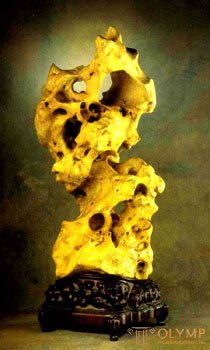 Under the name of the pussy, the mysterious are united, and the Chu Sho ishis are abstract stones. They are not like anything definite, but too beautiful to pass by and represent an inexhaustible source of inspiration.
Under the name of the pussy, the mysterious are united, and the Chu Sho ishis are abstract stones. They are not like anything definite, but too beautiful to pass by and represent an inexhaustible source of inspiration.
Many centuries ago, John Duns Scott suggested that stones are also living beings, just their life is too slow for people to notice. Perhaps this is the case for real lovers of suyseki, whose skillful hands and creative imagination are really able to revive the stones.
The art of admiring "wild", untreated or almost untreated stones is one of the still little-known aspects of the Culture of Japan, Korea and China. Of course, people paid attention to the beauty of "non-precious" stones even in ancient times, and not only in the Far East. During the excavations in Oldduvae, Lewis Leakey found not only the skulls of the most ancient people, but also small ocher cracks, which these, not entirely still people, brought 1.5 million years ago from afar (not less than 20km!). Why did primitive hominids need ocher? It cannot be eaten, it is unsuitable for making chopped, there were no signs of use as a dye either. The only explanation is that the red stones awakened in our distant ancestors a sense of beauty. Stones, and, probably, flowers ... Just the flowers could not survive.
Stones and flowers ... Lively, eferennoe and static. Two Pole Nature.
Already in the 5th century AD, the Japanese sought to unite these poles. Thus arose the Bonsai-seki, stones that complement the bonsai. Almost simultaneously with them (and in China a bit earlier), the art of admiring the stones themselves appeared. In Japan, such “meditative” stones are called Suiseki (interestingly, the word itself is Chinese!), In China, Gongshi.
The word Suiseki itself gave rise to a combination of two Chinese characters: "Sui", - water and "Seki", - stone. Gongshi was born from a combination of hieroglyphs "Gong" - Mount "Shi", - student. Although both words are Chinese in origin, Suiseki’s art has reached its greatest development in Japan (although interships and works made in the Chinese school have been growing recently).
So what is Suiseki?
At first glance, ordinary stones. Granite, quartzite, petrified loess. Cobblestone, in a word. This is if one ... And if three: "Stone is Possessing Individuality." Europeans who are interested in unusual art more often call them Spirit Rocks or Meditative Rocks (ie. Spiritual Stones or Stones For Meditation) This is probably the secret - Suiseki do not reveal their beauty “at the first requirement”, they are not so bright and throws like precious or ornamental stones to enter their world, enjoy the inaudible melody, a person must “tune in” to the stone, learn to hear what the Bible calls the “voice of subtle silence”.
Suiseki can be used as an element of bonsai (or succulent compositions), as components of "rock gardens" and, finally, by themselves, being in this case a self-sufficient object.
As a rule, stones for Suiseki are not treated at all. In some cases it is allowed to form a flat cut for stability, but the real connoisseurs of Suiseki believe that it is better to achieve a certain position of the stone with the help of an appropriate form of the stand (Daiza, with its flat form or Doban with a more complex one). Classic Daisa made of wood or porcelain, Doban - from bronze. Nowadays, even in Japan, new materials are often used (including plastic), but there are also conservatives who believe that this is unacceptable, although they do not argue that in some cases new materials make it possible to more fully reveal the beauty of Suiseki.
In the Chinese school, light polishing of the stone is allowed, and even gluing of harmonizing stones into a single whole. In this case, Suiseki is called Biseki . For all other cases, no "violence" over the stone is unacceptable.
Each Suiseki has a “face” - the side by which the stone must face the viewer during meditation.
Individuality is a necessary feature of suyseki. Therefore, crystals, as a rule, are not suyseks (except for some druses).
Suiseks should have a “history”, these should be stones that have been ground with water, or that have been affected by temperature fluctuations (in the second case, we have a Sabak Ishi stone (desert stone) of style.
The individuality of the stone can be created as a form and veins, velucheniyami other colors. Such "colored" stones belong to the style of Mont-Secy.
Chinese interest in collecting stones for religious and aesthetic purposes dates back to the time of the Han dynasty (206 BC - 220 AD), when Chinese thinkers began to use large stones to decorate their gardens and courtyards. Mention of "garden stones" is also found in poems dated by the time of the Tang dynasty (618- 907). At least since the Song dynasty (960-1270), educated and thin in an artistic sense, the Chinese began to appreciate small single ornamental stones, calling them Gongshi, in English - Scholar's Rocks - spirit stones, stones for contemplation .
Thus, initially in China, awareness and understanding of the beauty of large “garden” stones appeared, however, the small size allowed the Chinese to bring decorative stones to their homes, where they could admire shapes and originality of stones and reflect on them in their homes, which often served as workshops. . At first, the Gongshi were stones that resembled or resembled mythological or real-life mountains, or even the existing mountain ranges of China. Sometimes these were stones with unusual shapes, sometimes they were of a bright color, some stones evoked feelings in the contemplator. Gongshi originally appeared from the Chinese garden stones, whose height reached ~ 1.5 - 1.8 m. Over time, calligraphers, writers, poets, artists of China, Taoist monks wanted in their studios, where they write or paint, they were these stones are similar to the mountains, processed by nature itself, allowing them to engage in meditative practices here. So smaller stones became very popular among writers and representatives of the Imperial Court, they were given to each other, and also presented to representatives of the royal dynasties of other countries, for example, Japan. Since then, the art of Gongshi has been living for more than 1000 years.
The Chinese term Gongshi refers to stones that satisfy the above conditions and cause any feelings to the viewer. Despite the fact that the translation from Chinese gong means spirit (“spirit” -engl.), Shi is a stone (“stone” - English), the term Spirit Stones did not take root in English (that is, “stones for Souls "), and the name Scholar's Rocks (teacher's stones) got accustomed.
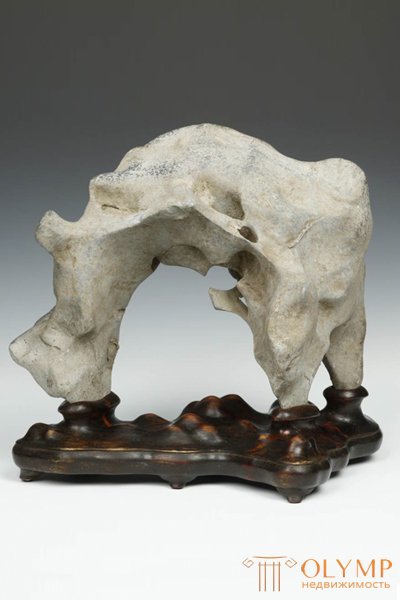
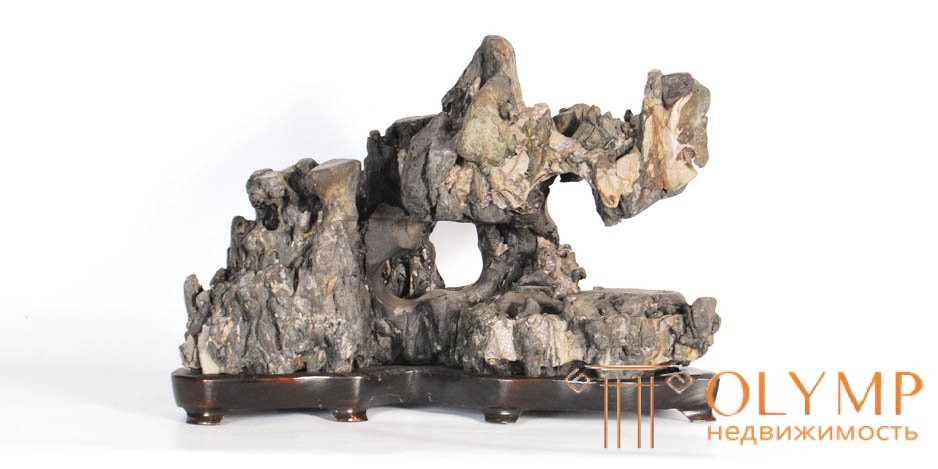
The earliest known stone gardens, which appeared during the Han dynasty, depicted people's ideas about an unreal place — a paradise known as Penglai — the Eastern Immortal Island. These are three high mountains (or more) with rocky, inaccessible peaks in the Eastern Sea, isolated from the rest of the world and even from each other. Since the Immortals could fly from one mountain to another, they could communicate with each other, but for ordinary mortals these paradise islands were inaccessible. In Chinese painting, these gods are often depicted in the form of cranes, flying between high mountains. The three paradise islands were called Fanghu, Yangzhou and Penglai, together - Penglai. Later, these islands were reflected in Taoism: the mountains of paradise were either mountains floating among the clouds, or skillfully made grottoes inhabited by the Immortals.
One of the first such gardens was built in the 2nd century BC. It was a large pond with four mountain islands — Penglai, Fangjand, Yangzhou and Juliang in the center. In the future, the emperors of China often repeated this composition in their gardens.
The stones in the gardens were located singly, - then they depicted a separate mountain; or in groups - for the image of the mountain range. Single stones of high decorativeness usually occupied the most prominent place in the garden. Most garden stones are white or gray in shades, of unusual shape due to strong weathering, up to 4 m high from the base. Among the collectors, stones found in Lake Tai of Jiangsu Province - Taihu-shi were especially valued. These are stones of large sizes and bizarre shapes, indented with many holes and recesses. Many of them have survived.
In comparison with garden stones, Gongshi is smaller and more sophisticated in shapes and shades. Their size ranges from miniature to ~ 1m and should be small enough for the Gongshi to quietly be placed on the table in the house and serve to reflect their owners. Sometimes such stones turned into quite ordinary objects that can be used for a specific utilitarian purpose, for example, as a brush holder or a print, but they still had to look like artistic creations. Especially prized stones of dense limestone, which "when struck emitted a ring in the form of a bell."
Gongshi located in the house on a special table or on a regular table. At the same time, for sustainability, Gongshi was placed in a wooden stand specially cut out for them, which in itself could be an object of art: various symbols, mythological paintings, hieroglyphs were depicted in very detail on it.
In China, black (Lingbi-shi) and gray (Yang-shi) slates are considered the most valuable stones.
Although black stones are still the most valuable, Gongshi’s art allows for other colors: white, yellow, red. Moreover, it should be said that in different periods of the history of China, various stones also became popular. For example, during the reign of the Ming and Quing dynasties (1368- 1911), collectors were loved by bright colored stones such as marble, malachite, turquoise, yellow quartz, soapstone, serpentine (serpentine).
Большинство Гонгши напоминают горы: реальные и несуществующие, скалы, одиночные пики и целые хребты. Но также существуют камни, вызывающие у ценителей воспоминания о великих людях, животных, героях мифов и легенд. Именно такие камни учат китайцев восхищаться поверхностью камня, которая говорит о его тысячелетнем возрасте; сильно изрезанной формой камня, говорящей о величии природы; любоваться его слоистой структурой, передающей глубину камня; наслаждаться его многочисленными углублениями, полостями, отверстиями, пещерами, создающими ритмичные, гармоничные узоры.
Для понимания Гонгши важное значение имеет одна из важнейших категорий в даосизме – категория «Пу», которая переводится буквально как «необработаный кусок дерева», что олицетворяет энергию нетронутых природой предметов: вещи в их собственной природной простоте содержат в себе свою собственную природную силу; если эта простота изменяется, то и природная сила вещи отбирается у неё и теряется.
Самыми прекрасными Гонгши считаются камни Тайху-ши - с очень изрезанной поверхностью, причудливых форм, с многочисленными углублениями, отверстиями, - но к созданию которых прикоснулась только природа.
Однако стоит признать, что над большинством таких камней поработал человек: в них высверливались дыры, искусственно изменялась поверхность, затем камни снова помещались на некоторое время в землю, после чего подвергались полировке. Зачастую после всех этих манипуляций камни опускали в воду для придания их поверхности естественного покрытия. Но знание того, что все эти процессы могли иметь место, не должно заслонять того факта, что перед нами – произведение искусства.
It is interesting that in the USA in the state of Texas you can find Gongshi, who are not inferior in quality to white Chinese Taihu-shi (from Lake Tai in Jiangsu Province) and black Lyngbi-shi (from Anhuai Province). Such a “leaky” structure of the local stones is explained by the presence of an endless limestone labyrinth in aquifers feeding the water flows. For millions of years, these calcareous abrasive particles, along with water, “artistically processed” the stones of grottoes and caves that make up these aquifers. The most "promising" places to search for interesting stones are the bottom of small coves where these aquifers go, especially after heavy rains. It is possible that such places you will find near your home.
Gongshi design tips from famous Chinese collector Hu Tsaokang.
Gongshi choose
- first, for their unusual or very beautiful shape,
- secondly, for their beautiful color,
- thirdly, for the material from which they are made.
In turn, in the form of Gongsha, above all matters:
- the presence of holes (Tou),
- the presence of tunnels (low),
- thickness (show) - the thinner the better
- the presence of wrinkles, folds (tsou).
Even if you are very lucky and you have become the owner of real “divine” Gongshi, this does not mean that you can correctly express your artistic concept through them. One solution to this problem would be the grouping of stones, in which their advantages are favorably emphasized and the disadvantages are hidden. For example, four or five stones with different heights can be arranged in a group with several miniature trees. This will create natural landscapes with beautiful mountains in a limited space. Stones for the group are selected from similar materials and with a similar texture. Keep them separate from each other, each on its own pedestal, and then when you change your artistic tastes, you will easily change the already annoying picture.
In Japan, the first stones for contemplation (in Japanese - Suiseki) appeared at the end of the 6th century AD. from China. They were donated by the imperial court of China to Empress of Japan Suiko. Like all Chinese Gongshi, these were vertical stones of very bizarre forms with holes, hollows, with strongly eroded surfaces, symbolizing the mountains and rocks of China. For a long time (several hundred years) they remained extremely popular in Japan, but only for a very narrow circle of people - the imperial court and aristocracy.
The next stage in the development of stones for contemplation is the late period of the reign of the Kamakura dynasty (1183-1333), when the samurai warrior class came to power in Japan. The close ties between Japan and China, the active trade between them leads to the rooting of Zen Buddhism in Japan - a new religion-philosophy - which received the approval and recognition of the samurai. For his followers, Zen Buddhism emphasized the need for asceticism, severity, simplicity, and understanding of the essence of things, intuition was carried out through meditation. Stones have also changed: in this period, stones with more refined lines acquire special value.
During the reign of the Muramachi dynasty (1338–1573), this trend only intensifies and develops. Buddhist monks give preference to stones in which the essential elements of stones are exposed. At the same time, other “distracting” details are not important. Over time, the preferences of monks become directed towards stones, resembling not just abstract landscapes, but possessing some particular feature, for example, depicting mountains. Such stones are used for spiritual purification, inner awareness and enlightenment. And the tastes of monks in Japan predetermined the tastes of the ruling class.
During the reign of the Edo dynasty (1603–1867), a new influential class rises in Japan - the class of wealthy merchants, who allow themselves to compete in their acquisitions, interests, hobbies with the aristocracy. Suiseki belong to their interests. In addition, it is worth noting that this period is also characterized by the extreme isolation of Japan, which closed its borders for any intervention. It was this period of isolation, unlike all the previous ones, when Japan was only a successor and follower of China, allowed the art of Japan to find its own, to any other similar characteristics and unique charm.
At the end of the 19th century (the period of the Meiji dynasty of 1868-1912), due to the impoverishment of the nobility and samurai, the development of certain types of Japanese art underwent a period of stagnation. However, it was at this time that Suiseki’s first classifications appeared.
In the second half of the 20th century, interest in stones for contemplation again revived, grew and spread to other countries, where it continues to grow in our time: Suiseki clubs today are common and unite people all over the world.
The history of the development of stones for contemplation in Western countries. Gongshi and Suiseki.
It so happened that in spite of the fact that the art of contemplating stones was first born in China, its development in the rest of the world, except Southeast Asia, was due to the influence of Japanese culture. In the West, it all started with bonsai exhibitions, which also included Suiseki. They quickly achieved the recognition of the audience and stood out as objects of a separate independent art direction.
It is interesting to note that public exhibitions of bonsai (and, presumably, suyseks) in Western countries were organized long before similar exhibitions in Japan: in France, England and the United States bonsai were exhibited at numerous fairs and international exhibitions from 1860 to 1920 . whereas in Japan the first public demonstration was organized only in October 1927 in Tokyo in Hibiya Park, and then every year after 1933. It was an exhibition of Kokufu-ten Bonsai Exception, and its venue now was the Metropolitan Art Museum in Tokyo in Ueno Park. It should be said that in Japan, bonsai, Suiseki exhibited long before the end of the 20s of the last century, but these were private shows in traditional Japanese restaurants.
The appearance of books by Japanese authors: John Naka on the West Coast and Yuji Yoshimura, together with Vincent Kovallo on the East Coast, who laid the foundations for Suiseki’s collection and exposition, accelerated recognition of this art form in the United States. Melba Tucker, Jim Greaves, Frank English, Bill Valivanis, Felix Rivera and Jim Hayes, who later created new trends in the development of Suiseki, “grew” out of these books.
As for the Chinese Gongshi, although in the life of the Chinese the stones for contemplation have been present for more than a thousand years, Western countries became interested in the Chinese Gongshi only about 20 years ago. This was due to the exhibitions of the collections of Yang and Susan Wilson, Richard Rosenblum and the books of Kemin Hu with illustrations of stones by famous Chinese collectors S.S. Wang and Hu Tsaokanga.
Stones for contemplation in the West (Viewing Stones) combine both forms of this art: Suiseki in Japan and Gongshi in China. In addition, the stones for contemplation allow the inclusion in this group of all interesting stones from around the world, as well as the emergence of any new forms. For example, Melba Tucker introduced a new category of stones - “Desert Stones” - amazing stones found in the desert - desert stones.
However, it is worth noting that it was in Japan that the first detailed classification was developed for Suiseki, which was further developed in the West due to earlier recognition of Japanese culture in the West compared to Chinese. Emerging new forms of stones include Suiseki’s already existing classification, expanding it. Today, the concept of Suiseki is often identified with a more general concept - the stones for contemplation, the Viewing Stones, although, to be more precise in the definitions, Suiseki is the Japanese style of the stones for contemplation.
Since the stones in China usually depict mountains that are mythological or real in nature, the Gongshi are placed in a vertical position, while the Suiseki in a horizontal position. Chinese styles Taihu and Lingbi do not require a flat surface to indicate the bottom of the stone, moreover, ideally, these stones should have a rugged, “interesting” surface from all sides, that is, the stone should be three-dimensional. Otherwise, if one of the sides of the Gongshi is flat, it is called two-dimensional, and this is considered a disadvantage for Gongshi: according to the laws of China's design art, the stone must be well balanced and have equal appeal from all points of view.
Because of the differences in the location of stones in China and Japan - vertical / horizontal - there are differences in the supports for these stones. For Gongshi, they are cut out much deeper (in order to keep the stone in an upright position), then five legs are usually attached to the pins on them, after which carvers proceed to the design of the stands. The final touch is the dyeing of the stand in a dark tone.
The history of the development of the art of "stones for contemplation" in Korea
The time when the stones for contemplation were brought from China to Korea is not precisely known: from 100 BC until 1300 AD Korea was then called Kokurea. This is the time of the spread of Taoism from China to Korea, with which stones appeared. Here they are called Suseok.
Due to China’s strong all-round influence on Korea, preference for stones was also given to the Chinese style: vertical stones with highly perforated surfaces were considered the most valuable and collectible Souseok. It lasted until 1950
Since 1950, Japan has had a profound influence on history, and, accordingly, on the culture of Korea. The tastes of collectors are also changing: instead of the traditional sharp, rugged, textured stones, they now choose more softened, muffled stones, which they worship in Japan. As for the number of collectors Suceok, then after the end of the Korean War (1950–1953) it grew significantly, continued to grow, and five years ago, according to experts, was about a million people. Recently, however, the number of collectors Suceok began to decline.
The main difference between Suseok and Suiseki is the principled and absolute non-interference of man in the nature of the stone - this is influenced by China. The Japanese, too, are trying not to change the stone, but for them it is precisely permissible to make the bottom of the stone for stability flat. Koreans prefer to leave "everything as it is", inventing various devices for exposing the stone: put the stone in a deep "suban" - a ceramic container with sand or water - or in a deeper wooden carved stand - daezwa or zvadaye. In addition, the stands for Suceok, Suiseki and Gongshi also differ: they are usually thinner for Koreans, and their smooth contour lines turn into legs (for the Japanese, the legs are missing in the stand and attached to the stand for the Chinese) .
Here are some famous places in Korea where Suseok is found. All these places are named after the rivers and rivulets on which are: Kuungho-kaang, Namkhan-kaang, Taevkha-kaang, Yung-kaang. In addition, the coastline is very popular with collectors, especially the southeast of the Korean Peninsula. There is a place not related to water to search for Sukeok - Ziri-san. Ziri is a mountain in Korea.
Что бы оставить комментарий войдите
Комментарии (0)